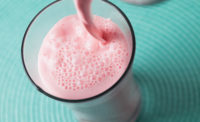Today’s health-conscious consumers like to know exactly what’s in their food. And they want it to be clean, whole and natural. Dairy products with whole fruits will appeal to this demographic. In fact, some product marketers tout the exact fruit content (in pieces or cups of fruit) on labels or websites.
No-added-sugar claims
The new Nutrition Facts regulations will require manufacturers to declare added sugars. Products with whole fruit, as opposed to those with concentrated fruit juice, will have the advantage of being able to claim “no added sugars.” In January, the Food and Drug Administration issued New Guidance on sugar declaration for fruit. The guidance document provides important clarification for industry.
According to the document: “If the ingredient contains all of the components of a whole fruit or vegetable, but has been processed so that the plant material is physically broken down into smaller pieces or water is removed, we would not consider the sugars contributed … to be added sugars” (emphasis added). The new guidance document also clarifies the somewhat tricky calculations for added sugars from fruit juice blends.
Superfruits and antioxidants
Bananas are touted for their potassium levels, citrus fruits for their vitamin C, and apples for their fiber. The term “superfruit” generally refers to fruits with higher levels of antioxidants. Although there is no exact definition of superfruit, cranberries, blueberries and raspberries are frequently awarded super status. The most popular fruits associated with an antioxidant claim in 2016 were pomegranate, goji berry and acai, according to global new product launch data from Innova Market Insights. One fruit to watch is tart cherries, which are available dried or frozen for dairy applications.
“With more than 60 research studies, Montmorency tart cherries have been linked to an array of important health benefits, and the evidence is growing,” said Jeff Manning of the Cherry Marketing Institute. “Consuming Montmorency tart cherries may help increase overall duration and quality of sleep, reduce inflammation related to gout and arthritis, decrease muscle pain after exercise and protect the heart by lowering levels of cholesterol and triglycerides,” he said.
Strawberries in yogurt, cheese, milk
Interestingly, traditional fruits, especially strawberry, dominate dairy applications. Strawberry was found in nearly one-quarter of fruit-flavored yogurt launches tracked by Innova Market Insights in 2016. Peach and blueberry were the next most prevalent, both with 9%, followed by raspberry (8%), mango (6%) and banana (5%).
For the wide spectrum of cheese products launched globally in 2016, Innova Market Insights also found strawberry to be the leading fruit flavor used, representing 30% of fruit-flavored activity for cheese, followed by banana (9%), raspberry (8%), cranberry (7%) and apricot (6%). In regard to fruit-flavored milk and milk drinks, strawberry was again the dominant fruit flavor. It was the fruit of choice 44% of the time, followed by banana (22%) and coconut (6%).
Enticing blends
Blending fruit with other healthy ingredients, including protein, boosts the overall product appeal. 2016 has been called the “Year of the Vegetable” and so it’s not surprising that companies are increasingly turning to fruit and veggie combos.
“The most popular varieties of Bolthouse Farms juices and smoothies include Green Goodness, Strawberry Banana, Amazing Mango and Berry Boost,” said Lauren Castillon, communications manager at C-Fresh, a division of Campbell Soup Co. “In March 2016 we introduced three new fruit and vegetable juice and smoothie blends including Berries and Green Veggies, Mango Pineapple Colada and Raspberry Blood Orange.”
Bolthouse Farms is just one of many companies that are touting the exact content of whole fruit on its labels. Its Berry Boost contains 2½ apples, ⅓ banana and 61 berries, yielding 3¾ servings of fruit.
Whole fruit
Whole fruits come in a variety of forms, including specially formulated ice cream and yogurt preps, to suit any dairy application. Single-strength and concentrated purees are suitable for beverages and smoothies. Whole fruits can be dehydrated and milled to produce shelf-stable powders. Dairy processors should look to sustainable farming and minimal processing of fruit as part of the story that they need to craft for today’s health-conscious consumers. Evolution Fresh’s “Protein Power Berry” contains seven fruits, whey protein and beets.
“Like all of our juices, Protein Power Berry is cold-pressed through a unique, high-pressure processing system to deliver more of the flavors, vitamins and nutrients of raw fruits and vegetables,” said Anne Williams, vice president, Evolution Fresh Marketing.
When exploring dairy and fruit combos, don’t forget cheese. Sweetened and dehydrated fruit pieces make a delightful addition to artisan cheeses.








